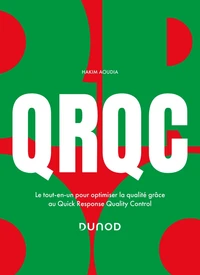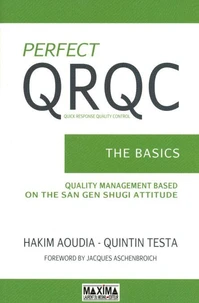Perfect QRQC - Prevention, standardization, coaching. Quality Management Based on the San Gen Shugi Attitude
Par :Formats :
Disponible dans votre compte client Decitre ou Furet du Nord dès validation de votre commande. Le format ePub protégé est :
- Compatible avec une lecture sur My Vivlio (smartphone, tablette, ordinateur)
- Compatible avec une lecture sur liseuses Vivlio
- Pour les liseuses autres que Vivlio, vous devez utiliser le logiciel Adobe Digital Edition. Non compatible avec la lecture sur les liseuses Kindle, Remarkable et Sony
- Non compatible avec un achat hors France métropolitaine
 , qui est-ce ?
, qui est-ce ?Notre partenaire de plateforme de lecture numérique où vous retrouverez l'ensemble de vos ebooks gratuitement
Pour en savoir plus sur nos ebooks, consultez notre aide en ligne ici
- Nombre de pages165
- FormatePub
- ISBN978-2-8188-0610-4
- EAN9782818806104
- Date de parution09/07/2015
- Copier CollerNon Autorisé
- Protection num.Adobe & CARE
- Taille4 Mo
- Infos supplémentairesepub
- ÉditeurMaxima
- PréfacierStéphane Rambeaud-Measson
Résumé
QRQC (Quick Response Quality Control) is one of the most powerful tools of Quality Management. It makes it easier to solve most of the manufacturing and functional problems in a simple and logical way.
Volume 1 presented QRQC initial steps (Detection, Communication, Analysis and Verification), as well as the first step of the approach ("RESOLUTION").
In Volume 2, three steps are explained in detail: "Prevention", "Standardization" and "Coaching".
The step "PREVENTION" aims to permanently eradicate problems, including on other production lines or in other locations or at other customers'.
The step "STANDARDISATION" involves building on experience from past mistakes through technical reviews, standardizing new robust design standards by using formalisation or updates, then implementing 100% of these design standards to 100% of the projects.
Finally the third step "COACHING" is probably one of the most important steps in the approach.
It presents a practical method of understanding and a training on the "Perfect QRQC" approach as a whole. With this second book, the author remains true to the principle that contributed to the success of his previous book: provide simple and educational guidance that is easy to understand by managers and technicians. Enable a practical implementation with positive and measurable results in terms of customer and staff satisfaction.
Remember that the management of problems is fundamental to the building of expertise and know-how in a company. Increase product reliability and product design which are the root cause of mutual trust between a supplier and its client
It presents a practical method of understanding and a training on the "Perfect QRQC" approach as a whole. With this second book, the author remains true to the principle that contributed to the success of his previous book: provide simple and educational guidance that is easy to understand by managers and technicians. Enable a practical implementation with positive and measurable results in terms of customer and staff satisfaction.
Remember that the management of problems is fundamental to the building of expertise and know-how in a company. Increase product reliability and product design which are the root cause of mutual trust between a supplier and its client
QRQC (Quick Response Quality Control) is one of the most powerful tools of Quality Management. It makes it easier to solve most of the manufacturing and functional problems in a simple and logical way.
Volume 1 presented QRQC initial steps (Detection, Communication, Analysis and Verification), as well as the first step of the approach ("RESOLUTION").
In Volume 2, three steps are explained in detail: "Prevention", "Standardization" and "Coaching".
The step "PREVENTION" aims to permanently eradicate problems, including on other production lines or in other locations or at other customers'.
The step "STANDARDISATION" involves building on experience from past mistakes through technical reviews, standardizing new robust design standards by using formalisation or updates, then implementing 100% of these design standards to 100% of the projects.
Finally the third step "COACHING" is probably one of the most important steps in the approach.
It presents a practical method of understanding and a training on the "Perfect QRQC" approach as a whole. With this second book, the author remains true to the principle that contributed to the success of his previous book: provide simple and educational guidance that is easy to understand by managers and technicians. Enable a practical implementation with positive and measurable results in terms of customer and staff satisfaction.
Remember that the management of problems is fundamental to the building of expertise and know-how in a company. Increase product reliability and product design which are the root cause of mutual trust between a supplier and its client
It presents a practical method of understanding and a training on the "Perfect QRQC" approach as a whole. With this second book, the author remains true to the principle that contributed to the success of his previous book: provide simple and educational guidance that is easy to understand by managers and technicians. Enable a practical implementation with positive and measurable results in terms of customer and staff satisfaction.
Remember that the management of problems is fundamental to the building of expertise and know-how in a company. Increase product reliability and product design which are the root cause of mutual trust between a supplier and its client






